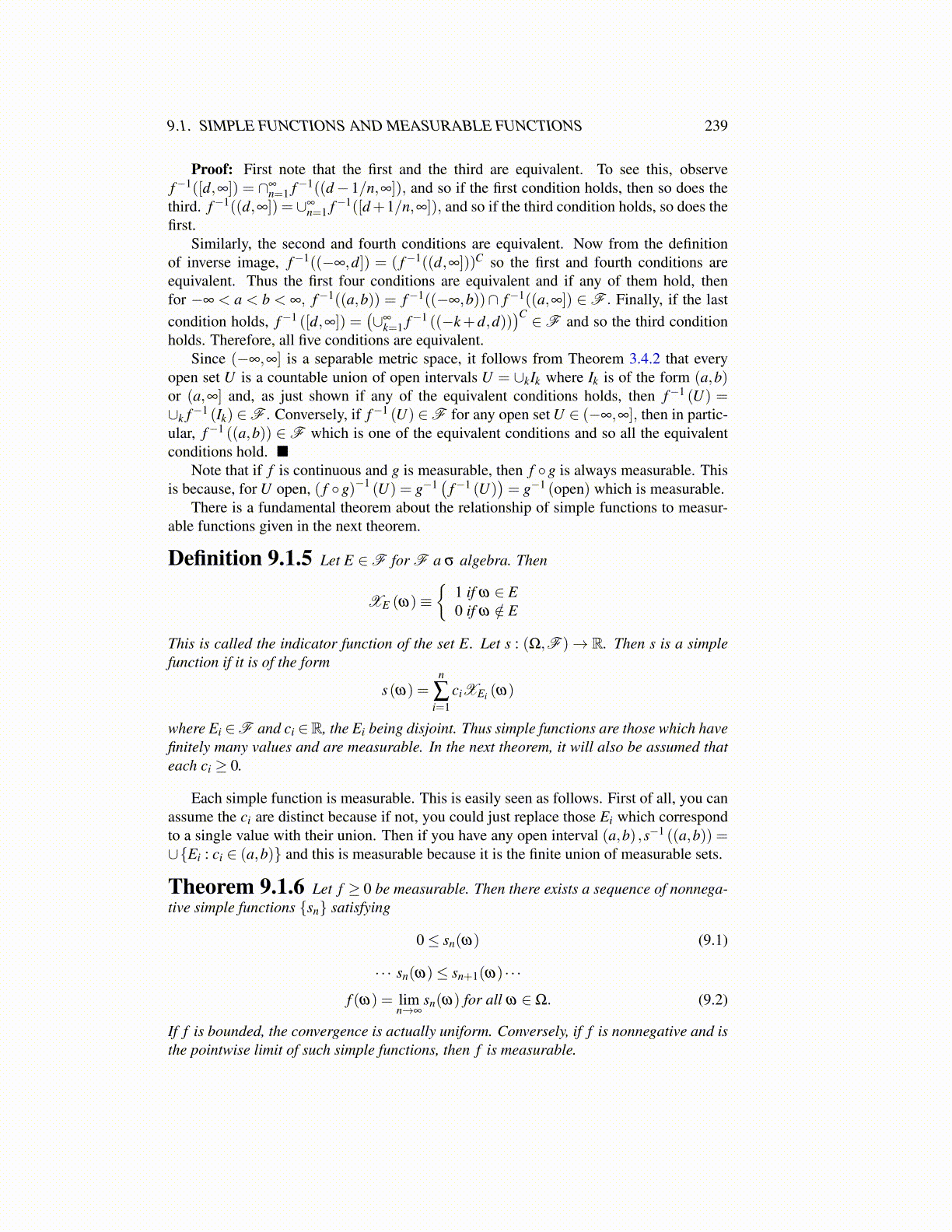
9.1. SIMPLE FUNCTIONS AND MEASURABLE FUNCTIONS 239
Proof: First note that the first and the third are equivalent. To see this, observef−1([d,∞]) = ∩∞
n=1 f−1((d− 1/n,∞]), and so if the first condition holds, then so does thethird. f−1((d,∞]) = ∪∞
n=1 f−1([d+1/n,∞]), and so if the third condition holds, so does thefirst.
Similarly, the second and fourth conditions are equivalent. Now from the definitionof inverse image, f−1((−∞,d]) = ( f−1((d,∞]))C so the first and fourth conditions areequivalent. Thus the first four conditions are equivalent and if any of them hold, thenfor −∞ < a < b < ∞, f−1((a,b)) = f−1((−∞,b))∩ f−1((a,∞]) ∈F . Finally, if the lastcondition holds, f−1 ([d,∞]) =
(∪∞
k=1 f−1 ((−k+d,d)))C ∈F and so the third condition
holds. Therefore, all five conditions are equivalent.Since (−∞,∞] is a separable metric space, it follows from Theorem 3.4.2 that every
open set U is a countable union of open intervals U = ∪kIk where Ik is of the form (a,b)or (a,∞] and, as just shown if any of the equivalent conditions holds, then f−1 (U) =∪k f−1 (Ik) ∈F . Conversely, if f−1 (U) ∈F for any open set U ∈ (−∞,∞], then in partic-ular, f−1 ((a,b)) ∈F which is one of the equivalent conditions and so all the equivalentconditions hold. ■
Note that if f is continuous and g is measurable, then f ◦g is always measurable. Thisis because, for U open, ( f ◦g)−1 (U) = g−1
(f−1 (U)
)= g−1 (open) which is measurable.
There is a fundamental theorem about the relationship of simple functions to measur-able functions given in the next theorem.
Definition 9.1.5 Let E ∈F for F a σ algebra. Then
XE (ω)≡{
1 if ω ∈ E0 if ω /∈ E
This is called the indicator function of the set E. Let s : (Ω,F )→ R. Then s is a simplefunction if it is of the form
s(ω) =n
∑i=1
ciXEi (ω)
where Ei ∈F and ci ∈R, the Ei being disjoint. Thus simple functions are those which havefinitely many values and are measurable. In the next theorem, it will also be assumed thateach ci ≥ 0.
Each simple function is measurable. This is easily seen as follows. First of all, you canassume the ci are distinct because if not, you could just replace those Ei which correspondto a single value with their union. Then if you have any open interval (a,b) ,s−1 ((a,b)) =∪{Ei : ci ∈ (a,b)} and this is measurable because it is the finite union of measurable sets.
Theorem 9.1.6 Let f ≥ 0 be measurable. Then there exists a sequence of nonnega-tive simple functions {sn} satisfying
0≤ sn(ω) (9.1)
· · · sn(ω)≤ sn+1(ω) · · ·
f (ω) = limn→∞
sn(ω) for all ω ∈Ω. (9.2)
If f is bounded, the convergence is actually uniform. Conversely, if f is nonnegative and isthe pointwise limit of such simple functions, then f is measurable.